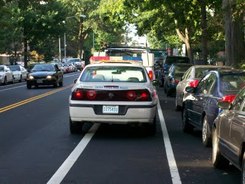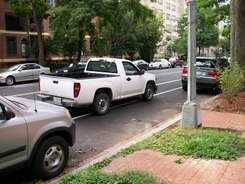Bicycles, drivers, and pedestrians all have their reckless minority
The eternal debate about the role of bicycling reached the Post this weekend. An editorial praises the rise of bicycling, pointing out how many more bicycles a street or parking space can hold compared to cars. WashCycle writes,
What’s heartening is that they never mentioned how “cyclists have to start following the law like drivers do.” Of course that didn’t keep the commenters from mentioning it, or things like “bikers interfere with traffic movement” and “With these added facilities, we can insist on licensing of bicyclists and make sure those who drive on the sidewalk, through red lights, through pedestrians, etc. are held responsible for their actions.”
The Boston Globe didn’t exercise the same restraint, leading Newton Streets and Sidewalks to imagine a world where newspapers called for driver responsibility when reporting on bridge repairs (which we covered in Breakfast Links last week). And Richard Layman writes, “Today’s editorial would have been far better had it called for stronger responsibility requirements for automobile drivers.”
That responsibility could start with simple behaviors like not blocking bike lanes. Bloomingdale (for now) recently posted several photographs of a bike lane on Vermont Avenue, which police cars and government trucks seem to treat as their own private parking lane. One truck even used the bike lane while leaving a large, legal parking space completely empty.
Meanwhile, a Close to Home piece decries dangerous cycling behavior. Diane Gibbs relates harrowing tales of cyclists zooming down hills, running red lights, knocking a friend to the ground, and even daring to yell at her for not staying on a certain side of the sidewalk.
Make no mistake: these cyclists were all behaving very badly. Their conduct casts all bicycling in a bad light. The simple fact is that whatever mode of travel we use, we see other modes’ transgressions much more vividly than our own mode’s. Cyclists see drivers constantly blocking bike lanes, drivers get annoyed by pedestrians stepping out into traffic without looking, and pedestrians have their nerves jangled by the insensitive cyclist.
This finger-pointing could continue around and around without end, and probably will. We need to all strive to break the cycle. Cyclists need to keep advocating for what they need to be safer while also criticizing the reckless. Drivers need to admit that many drivers put others in danger. Pedestrians deserve not to be corralled into too-narrow spaces at the edges of the street, but also need to pay attention in shared spaces.
We should look seriously into laws or enforcement to weed out the minority of bad actors without punishing everyone who uses a different mode, even if they’re a small minority. Kicking all cyclists off all sidewalks isn’t the answer. I’ve advocated for the Idaho Stop law, freeing cyclists from silly laws that don’t actually affect safety, in combination with enforcement of important traffic laws against cyclists, drivers and pedestrians alike. Is enforcement the answer to the real problems Gibbs relates, or do we need other laws?
In the comments, let’s try something. If you drive regularly, start your comment by relating a story of something bad you saw a driver do. If you bike most of the time, give a story of a fellow cyclist who acted unsafely. If you walk to work regularly, think of a recent pedestrian infraction you witnessed. I see all three on a daily basis. Surely you do as well.


